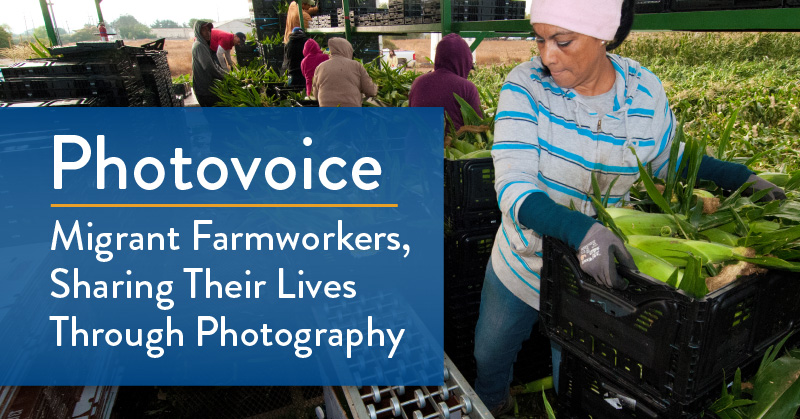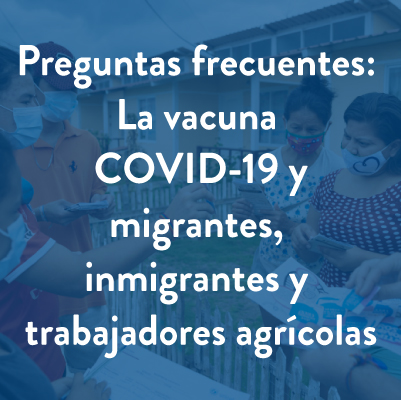- Who We Are
- Clinician Employment
- Publications
- Witness to Witness (W2W)
- El Premio Kugel & Zuroweste a la Justicia en la Salud
- Your Voice Matters: Photovoice Project
Wed, 12/02/2020 | by Robyne Hayes


[Editor’s Note: Robyne Hayes recently partnered with Migrant Clinicians Network on the Tu voz importa/Your Voice Matters project. Read more about the project here. In this blog post, Robyne shares the backdrop of the project. Support this project and many others by donating to MCN during our End-of-the-Year Giving campaign to show support for #HeroesOnTheFrontline. Please visit our GoFundMe page and share with others.]
Throughout my career I have used photography and qualitative research to understand communities that are not my own. My work has taken me as far away as Ethiopia, Nepal, and Bangladesh, but my current project, “Tu voz importa,” is much closer to home: working with migrant farmworkers in Northern California. While how I approach my work has changed drastically, my motivations have stayed constant – a deep curiosity about people and cultures, striving for a meaningful life. However, I have come to realize that the most conscientious and impactful role I can take is to reach out to marginalized, misrepresented, or invisible members of the community and engage with them through a platform that enables them to share their own views and vision.
As a social justice photographer and researcher, I love using the Photovoice method because it is an extraordinarily powerful tool for change. Photovoice projects are unique collaborative efforts between an artist and an identified community of participants. Once a population has been selected, the artist works to create a space for dialogue, encouraging participants to find their voice to speak about issues that are important to them.
Photovoice merges education with agency. Participants are taught the basic elements of photography and asked to document aspects of their lives through guided assignments. Participants then return to the group to discuss the images they have selected to share. Through this process, a safe space is created where participants are empowered to showcase their lives with the images that best represent the issues that are important to them. The tangible outcomes are a series of evocative images and stories that highlight issues that matter most to them. Together, these narratives are used to create pathways for dialogue and action, mobilize change-makers, and understand the needs of the community. The result is a stronger and more resilient community in which all voices are acknowledged.
After several years of engaging in this work, I have learned that participation in photovoice projects can be transformative because the participants build the necessary confidence and skills to be able to effectively tell their story from their own point of view. Much like those who participate in a Photovoice project, I value photography because it provides me with the means to communicate how I see the world, as well as my own place within it. This understanding likewise shapes my goal: by sharing the way I have found my strongest voice, I might help others to discover theirs.
When I work within a community on a project, I want them to understand that their voice, and their actions, are critical to creating change.
By raising the voices of farmworkers, women and youth specifically, we are hoping to shed light on their needs and perspectives. Hopefully, this will in turn bring program and policy creators to work directly with farmworkers to acknowledge and incorporate their needs and perspectives, as policy that affects them is created. Last year, the Center on Budget and Policy Priorities published a brochure that argued states can only prosper when favoring an inclusive approach to immigration, urging policymakers to adopt pragmatic pathways for these vulnerable communities to be seen and recognized. This is even more critical, at this point in time, given the fact that these communities are disproportionately impacted by external events. Within California, these participants have had to weather the socioeconomic impacts of COVID-19, while also grappling with devastating health consequences of wildfires. According to the Community and Labor Center at the University of California in Merced, these twin threats affected more than 381,000 migrant farmworkers. Yet most of these men, women, and youth members are ineligible for any aid, communicating that they are invisible.
With the sobering reality of these facts and figures in mind, I feel strongly that anyone who rises to the occasion to see and assist these communities deserves recognition. To that end, Tu voz importa has been made possible by an impressive consortium of working professionals, with varied backgrounds in art, health, law, museum curation, nonprofit management, and social work, to name just a few. Their support is crucial to amplifying the voices of participants, and empowering them to use their own agency for their respective health needs, and beyond. That is why I am choosing to support #HeroesOnTheFrontline by working in collaboration with the Migrant Clinicians Network, because their work is not only essential, but vital to the success of Tu voz importa. Through their support of frontline clinicians, we are able to help tell the stories that need to be told.
Through the sharing of the images and stories, I hope we can contribute to changing the current, national narrative of migrants. We must move away from the vilification and criminalizing of migrants to developing better compassion and understanding as a nation. I want to remove the barriers that make people view immigrants as an “us vs. them” dichotomy, and recognize that the only difference between us is the luck of where we were born, or the color of our skin. I want people to see themselves reflected in the stories of the women and youth we work with and how similar we really are.
Like what you see? Amplify our collective voice with a contribution.
Got some good news to share? Contact us on our social media pages above.
Return to the main blog page or sign up for blog updates here.







